Where you can ride your bike
Roads
You can ride on all roads unless there is a sign saying that bicycles are not allowed on a specific road.13 For example, bikes are often prohibited in motorway tunnels.
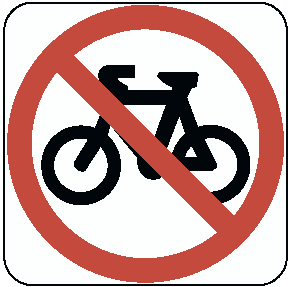
If you are riding side-by-side with another rider in the same lane, you must not ride more than 1.5 metres apart.14
Special purpose road lanes
Under NSW law, there are some lanes (or areas) of roads which are set aside for specialist use. These include bicycle lanes,15 bus lanes,16 tram lanes,17 tramways,18 truck lanes,19 and transit lanes.20
There are particular rules relating to the use of these lanes which all road users - including bike riders - must follow.
Bicycle lanes
If a bicycle lane is marked on a road and signed as 🚲 “LANE”, you must cycle in these bicycle lanes, unless it is impractical to do so.21
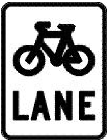
You should still be aware of other road users - and not only other riders - even when riding in these lanes.
This is because other road users - for example, those driving cars - can use these specialist bike lanes under certain circumstances. This is if they are entering or leaving a road at a driveway or intersection, and for no more than 50 metres.22
Bike lanes are different from bike paths, signed as 🚲 “ONLY”, where people driving cars are not ever allowed to drive or stop. Unlike a bike lane, using a bike path is optional – you are allowed to ride on the adjacent road if you prefer. For example, the separated cycleway on Bourke Street in Surry Hills.
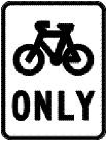
Bus lanes
Bus lanes are set aside for use by buses, but can also be used by bicycle riders without restriction. 23
However, you cannot use ‘bus-only’ lanes.24
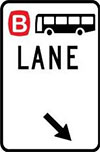
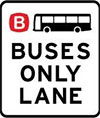
Tram lanes and tramways
You are permitted to ride in tram lanes, signified by a tram “LANE” sign.25
However, you cannot ride in tramways, signified by a tram “ONLY” sign.26
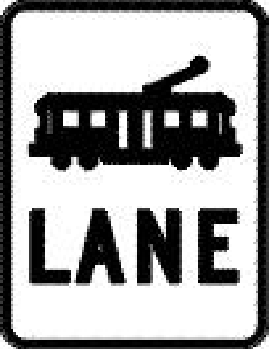
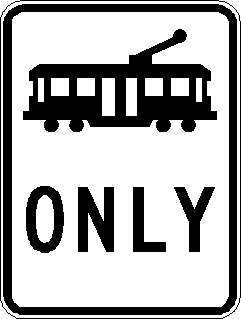
Truck lanes
A truck lane is reserved for vehicles over 4.5 tonnes in weight. However, you are permitted to ride in truck lanes.27
Transit lanes
A transit lane is reserved for use by vehicles with a minimum number of occupants.28 They are marked with ‘T2’ and ‘T3’ signs.
For example, you can drive in a lane marked ‘T2’ if you have two (or more) people in your vehicle.
You are permitted to ride in transit lanes.29
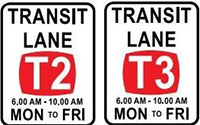
Footpaths
In 2018, there were changes to the laws as to when and where you can ride on footpaths.
There are some circumstances when a you are allowed to ride on footpaths. These include:30
- You are a child under the age of 16; or
- You are an adult that is accompanying a child under the age of 16 and the child is riding on the footpath under your supervision; or
- You are 17 years of age and are accompanying a child under 16 years of age who is riding on the footpath under the supervision of an adult; or
- You are carrying a person who is under the age of 10 as a passenger on the bicycle, or on a bicycle trailer (so long as the bicycle is not a pedicab).
When riding on the footpath you must give way to pedestrians and keep to the left of oncoming riders.
If illegally riding on the footpath you can face on-the-spot fines of $114.
Footpath riding and medical conditions
If a medical practitioner (or doctor) believes a bicycle rider should be permitted to ride on a footpath for safety reasons due to a medical condition they have, that rider can legally ride on the footpath if they are carrying a medical certificate stating as such from their doctor.31
A second person riding on the footpath with them is legally allowed to accompany them, as long as the affected rider is carrying their medical certificate.31
Shared paths
A ‘shared path’ is a footpath which is able to be used by both pedestrians and bicycle riders.33 It is usually marked by a sign which features the pedestrian symbol at the top, with the bicycle symbol beneath it.
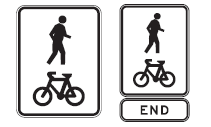
If a footpath has these signs that show that it is a designated shared path, then you are allowed to use it alongside people walking.
When using these paths, pedestrians always have right of way. You must keep to the left of oncoming riders and always give way to all pedestrians on the shared path.34
The Roads and Maritime Service recommend a passing distance of one metre on shared paths between bicycle riders and pedestrians.
If you fail to observe the displayed signs, or do not give way, you may be fined.
Separated footpaths
A ‘separated footpath’ is divided in half, with pedestrians on one side, and bicycle riders on the other.35 They are often marked with a sign displaying a pedestrian symbol and a bicycle symbol, side-by-side, with the word ‘ONLY’ below.
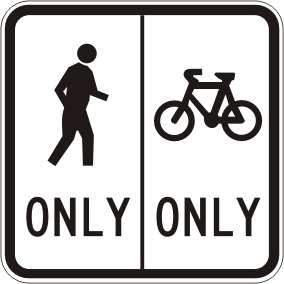
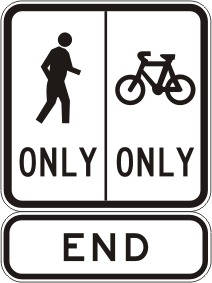
In NSW, it is illegal to ride your bicycle on the part of a separated footpath which is designated for pedestrians.36 If you do, you can be fined.
Can I ride across a pedestrian crossing?
You can only ride across a foot crossing with lights, if there is a green bicycle crossing light.
You are not allowed to ride across a children's crossing or a pedestrian crossing.37
You must dismount and push your bike over the crossing.
Reporting road and bicycle path hazards
If you see a problem or a hazard for bicycles, contact your local council or NSW Roads and Maritime Services with details about the nature of the hazard, how it can be identified and where it is located.
You can call the Traffic Line on 131 700 to report hazards such as a pothole or damaged sign (option 5 on the menu) or faulty traffic lights (option 4).
Footnotes
- Road Rules 2014 (NSW) Regulation 252
- Road Rules 2014 (NSW) Regulation 151
- Road Rules 2014 (NSW) Regulation 153
- Road Rules 2014 (NSW) Regulation 154
- Road Rules 2014 (NSW) Regulation 155
- Road Rules 2014 (NSW) Regulation 155A
- Road Rules 2014 (NSW) Regulation 157
- Road Rules 2014 (NSW) Regulation 156
- Road Rules 2014 (NSW) Regulation 247
- Road Rules 2014 (NSW) Regulation 153
- Road Rules 2014 (NSW) Regulation 158(2)(c)(i)
- Road Rules 2014 (NSW) Regulation 158(4)
- Road Rules 2014 (NSW) Regulation 158(2)(c)(i)
- Road Rules 2014 (NSW) Regulation 155A
- Road Rules 2014 (NSW) Regulation 158(2)(c)(i)
- Road Rules 2014 (NSW) Regulation 156
- Road Rules 2014 (NSW) Regulation 158(2)(c)(i)
- Road Rules 2014 (NSW) Regulation 250
- Road Rules 2014 (NSW) Regulation 250(1A)
- Road Rules 2014 (NSW) Regulation 250(1B)
- Road Rules 2014 (NSW) Regulation 242(2)
- Road Rules 2014 (NSW) Regulation 250(2)(b)
- Road Rules 2014 (NSW) Regulation 239(4)
- Road Rules 2014 (NSW) Regulation 249
- Road Rules 2014 (NSW) Regulation 248

